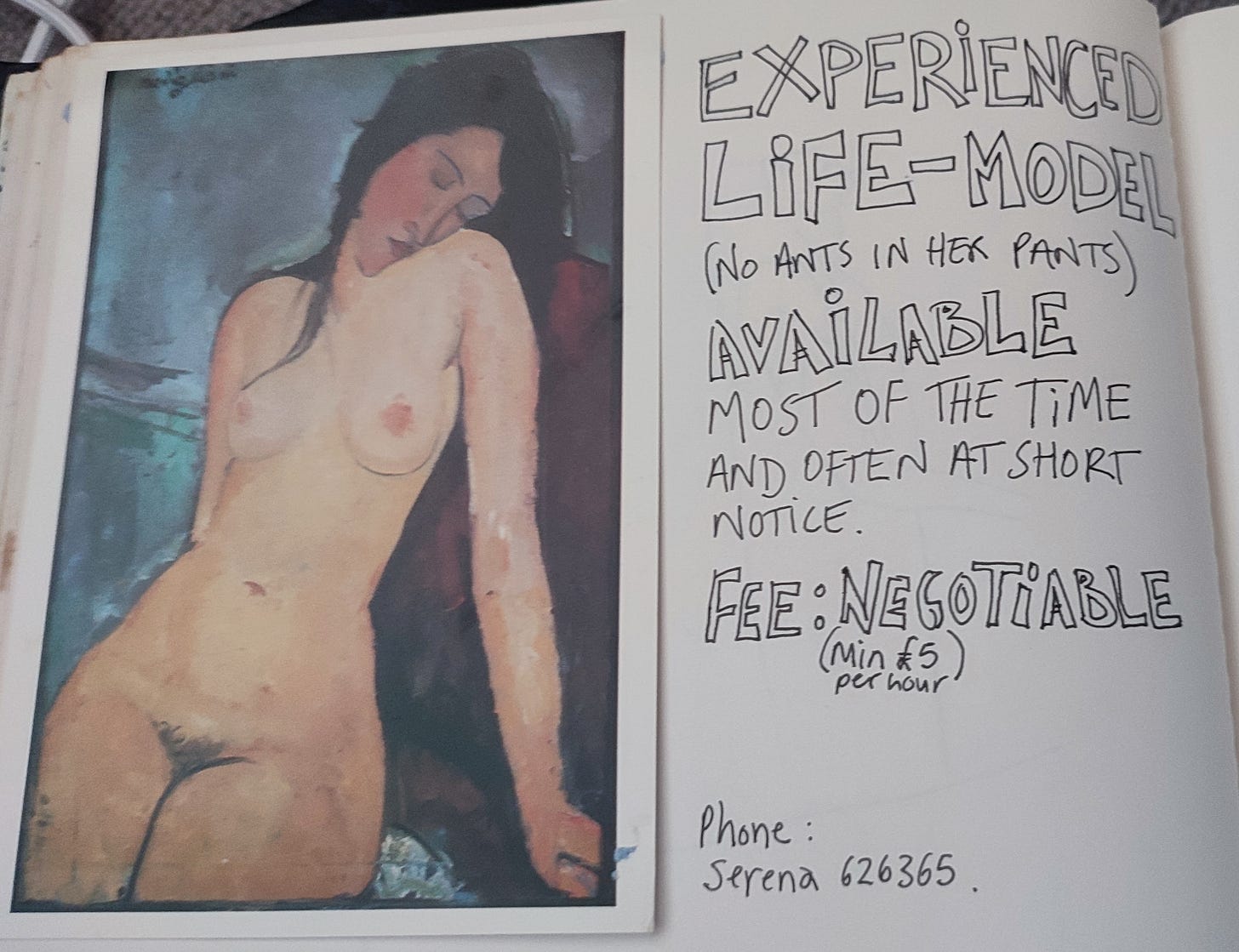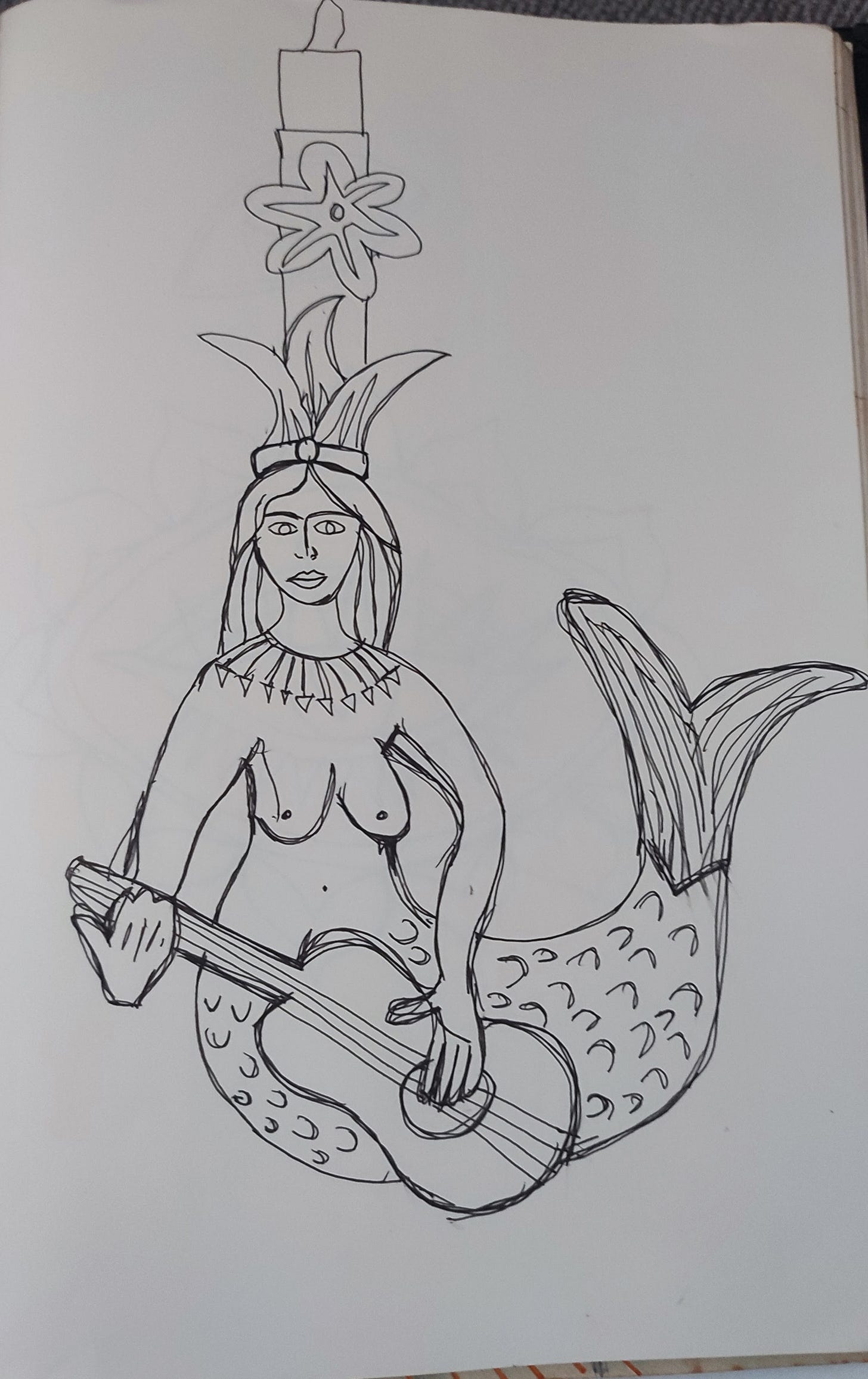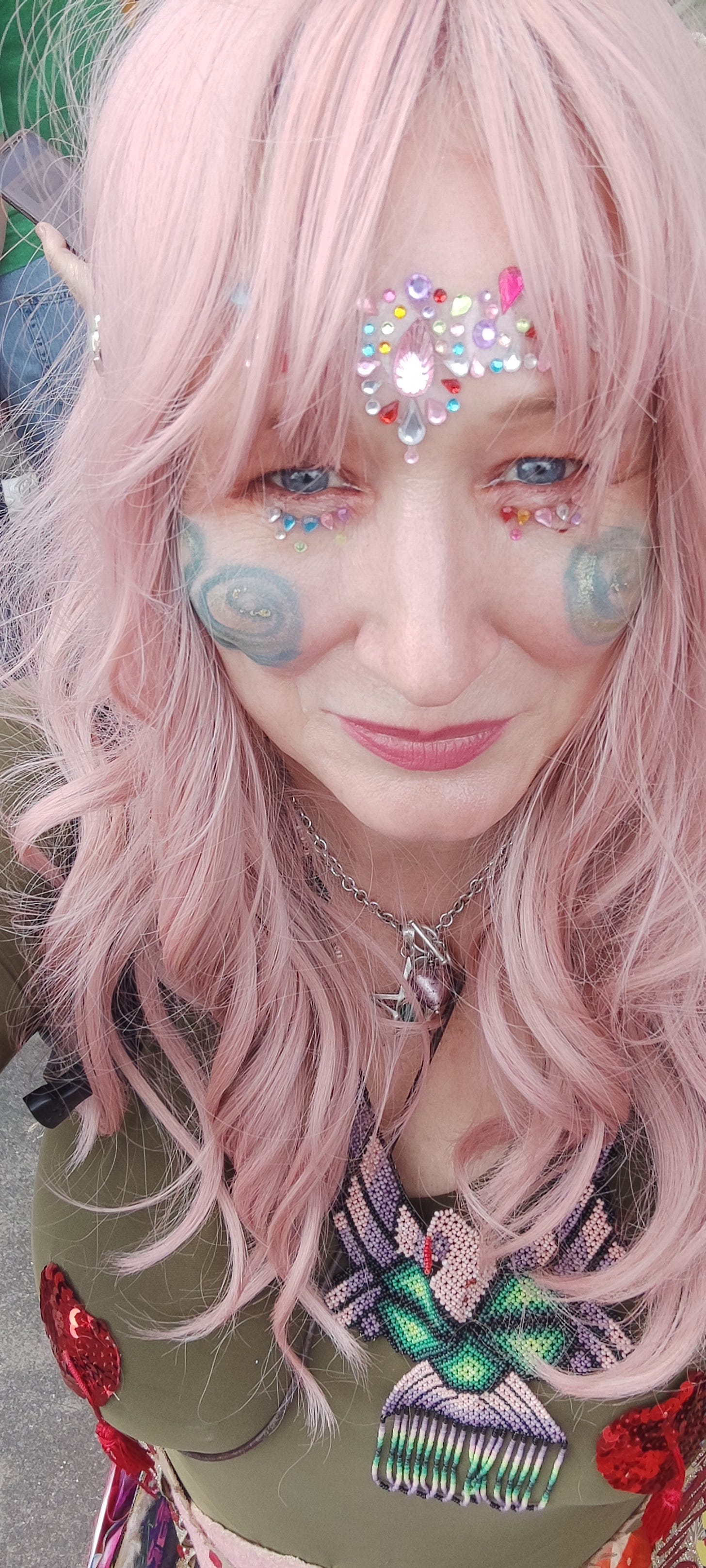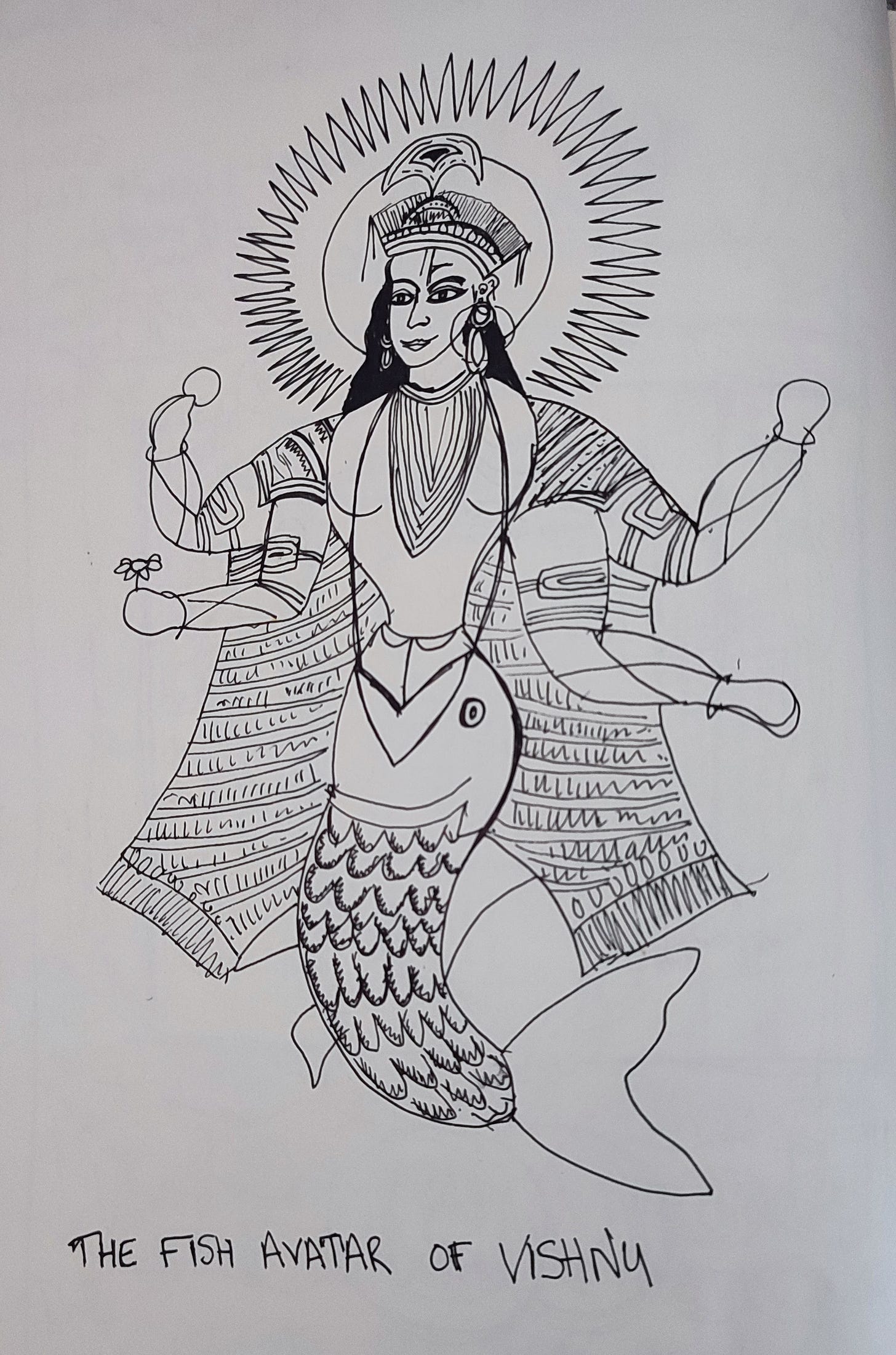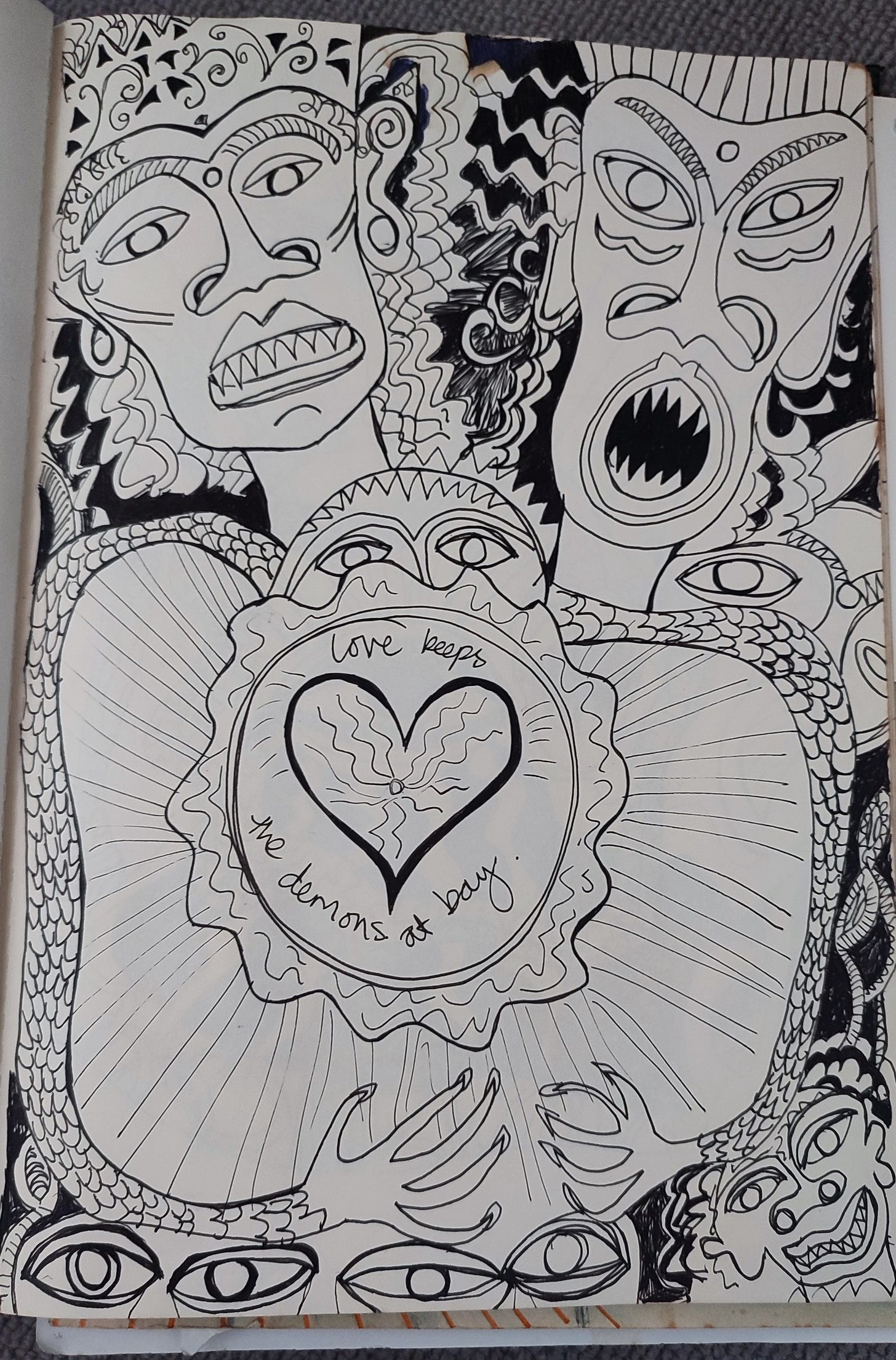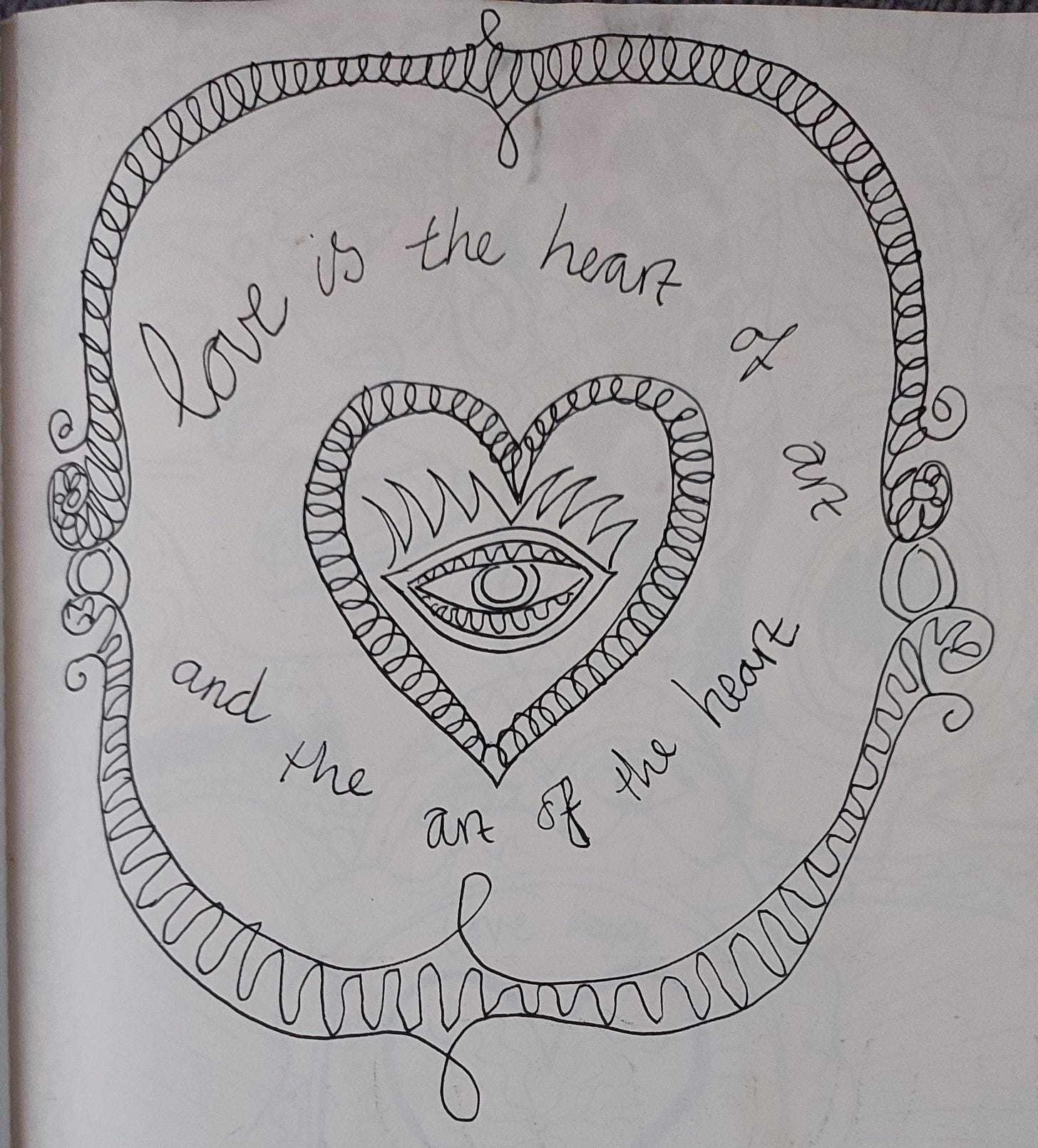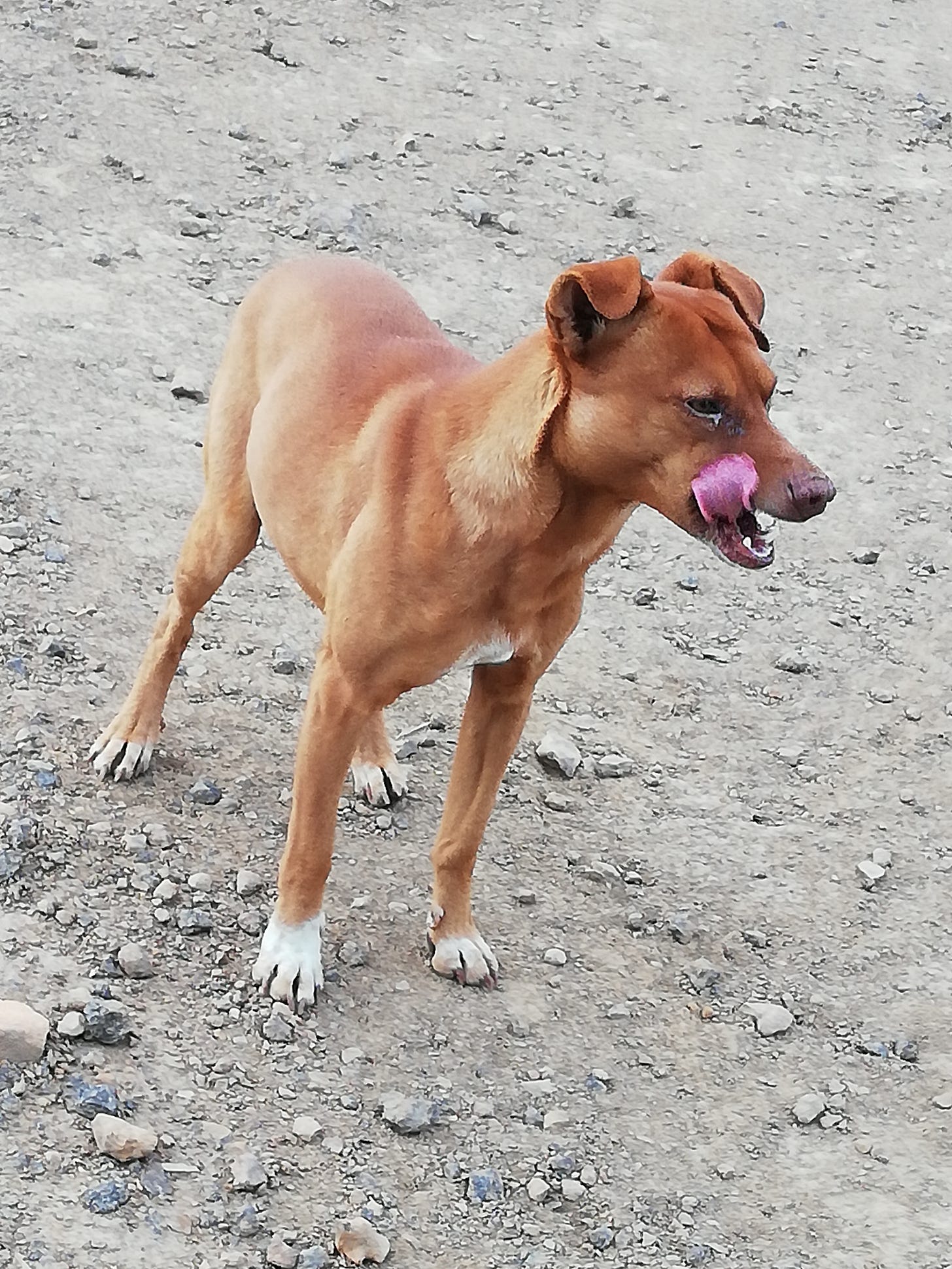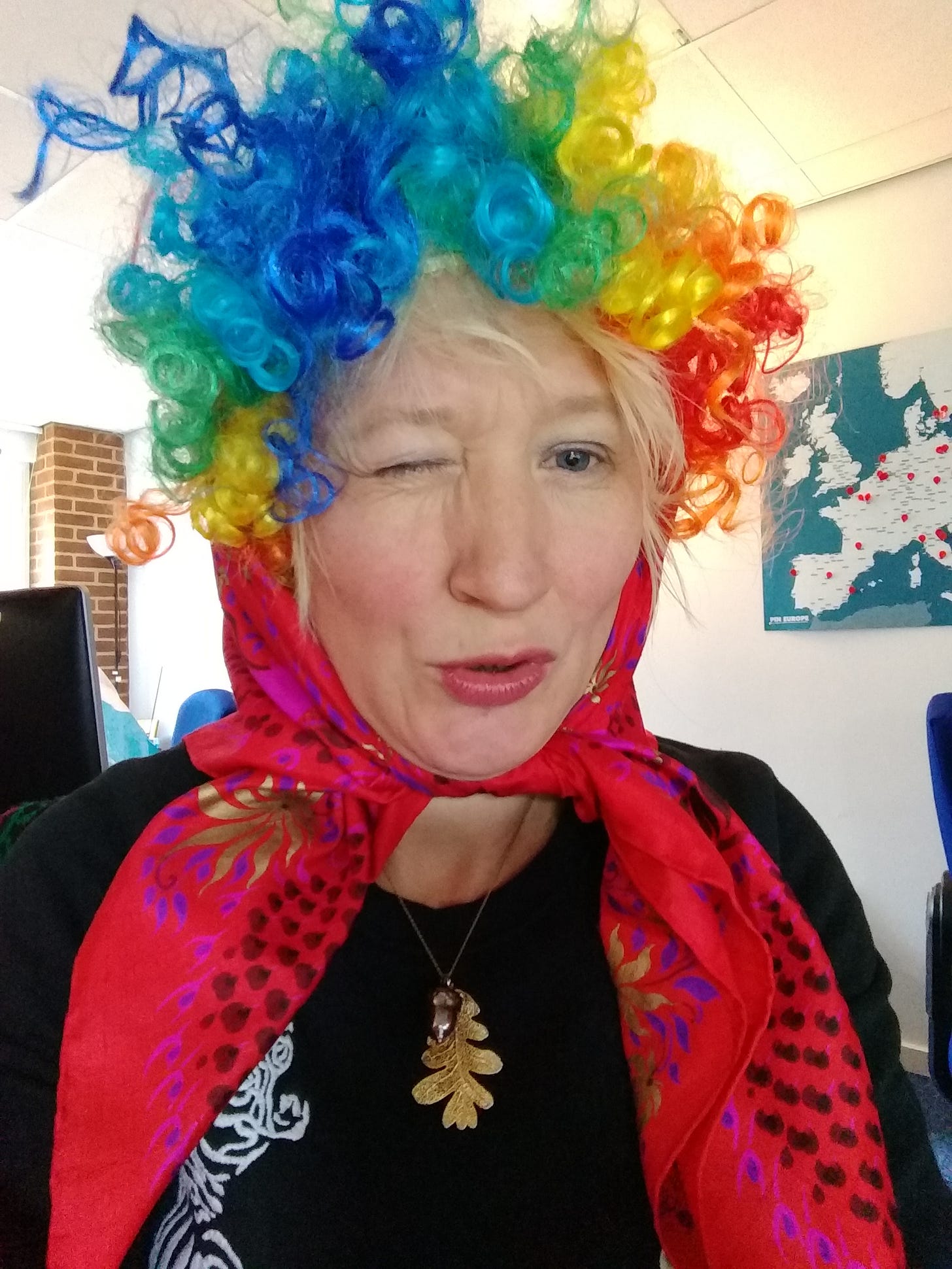The Body as Expression
An ongoing and current theme for me is about the body. I've written recently about soma and the somatic experience - feeling through the body and experiencing so much in my physical being. This past week, various aspects of the body have resurfaced again in my consciousness.
I attended an incredible performance at Folklore, a small venue in Hoxton in London's East End, where I met up with a dear storytelling friend who has also been on a profound overseas retreat. We shared our amazingly parallel experiences of rebirth and transformation due to our respective retreats. The storytelling by Swedish storyteller Kirst Stabi was about The Hairy Girl - the tale of "Tatterhood," a Norwegian fairy tale about twin princesses. The eldest twin, born covered in hair, is cast away for not embodying traditional beauty. Yet she becomes the true healer, following her radical path despite living with hair that society deems unattractive.
A Personal Relationship with Hair
This story sparked conversations about our relationships with hair. I first encountered "Tatterhood" through one of my storytelling teachers, Dr Martin Shaw, and have since worked with it in my workshops.. A companion piece, "The Lindworm," which I’ve also told, similarly explores embodiment, rebirth, and the painful process of shedding one's skin.
My relationship with hair has been complex. I never had the hair I desired - it didn't even grow until I was about two years old, just blonde fluff. I've always had short, fine hair that refuses to grow long. In cultures worldwide, luxuriant long hair represents the epitome of female beauty by traditional standards - a standard I could never meet. This has been my Achilles heel.
I've adapted by wearing hats, wigs, hairpieces, and headscarves, bringing colour, confidence and adornment to my crown in whatever ways I can. Recently, I decided to dye my hair blonde again, reconnecting with my wild twin self. For the last four years, I've let my hair remain in its natural state, which gave me a needed rest from chemicals that aren't good for us or the environment. Sometimes, though, we must do what serves our deeper needs. Mine was to return to my white tiger spirit.
Shedding Skins
I'm currently undergoing a process of shedding, literally shedding skins like the Lindworm. Eight weeks ago - only eight weeks, though it feels like eight lifetimes - I returned from an intense medicine retreat in Colombia. This unfolding, transformative process is beautiful, painful, and everything in between - a roller coaster of processing, life review, presence to whatever unfolds, and the shedding of old skin.
In Colombia, I committed to changing my diet, reinforcing a promise I'd made at the New Year. I’d gained so much weight last year. This might have been a reaction to medication I was taking (since discontinued), or simply overindulging in hummus, chocolate, and cheese - foods I love but consumed too freely! My metabolism has changed with age, and our bodies naturally need less fuel later in life. I had resigned myself: "Okay, so this is how my body takes shape in later life; like my grandmothers before me, I'll reluctantly accept this."
While not entirely happy with this situation, I had assumed it was unchangeable. Then, at the retreat's beginning, I connected energetically with beautiful old mango trees through my qigong practice. Nature speaks if you listen, and one particular tree communicated clearly: "I'm sweet enough. I am sweet enough. I don't need all this sugar and fatty crap in my body."
I listened. Mango was already part of my diet, but I've also since given up dairy - not 100%, but reducing to minimal amounts, moving toward a more vegan approach for health reasons. I still occasionally eat meat and fish when my body signals its need, ensuring it's quality and ethically produced food. I've committed to avoiding ultra-processed foods as much as possible in today's challenging food environment, and to finding time to cook properly; though I love cooking, time remains a precious resource. I need a personal assistant or housekeeper, but unfortunately can't afford to employ one!
Body Norms and Rebellion
Through this contemplation on the body, and my relationship with hair, I’ve been thinking about why such pressure exists for women to appear in certain ways. We are our own worst enemies. My rebel self, my wild twin, rejects these norms, which explains my affinity for growing up in the 80s with its post-punk, new wave rebellion against traditional beauty standards. We expressed ourselves authentically, differently, giving the establishment a defiant "up yours!"
Britain in the 80s emerged from the difficult 70s - a time of strikes, economic crashes, and a genuine mess in societal structures. Along came Prime Minister Margaret Thatcher, our first female prime minister, but who still very much embodied traditional establishment masculine energy. Her Conservative party sought to break trade unions and strikes such as the long-running battle with our miners who were striking to save their jobs from the pit closures. The shift from the collective society to the individual. Yes, coal mining involves fossil fuels that we must desperately and swiftly move beyond for the sake of climate change and the environment. The mines eventually needed to close, but the brutality and speed of the process damaged the collective body of society.
Our 1980s youthful reaction to the oppressive dismantling of worker-centred unionised communities manifested through our fashion choices - dressing to shock, to differentiate, to reject conformity to established ideals. This felt empowering.
Although my head hair would not grow, I've never needed to consider questions about shaving or managing body hair because I naturally have fine, almost invisible hair, and my feminist self would not be pressured anyway. Yet, at times, I've felt self-conscious about this characteristic. It remains my body vulnerability - we all have our insecurities.
Reflections on Past and Present
This weekend, while spring cleaning and going through old notebooks, I found myself in a process of shedding, not just 12 kilos of body weight but the weight of possessions accumulated over the years in my space-limited life. How much should go into storage? Much of what I already have in storage is inherited rather than personally chosen. Thankfully, I can pass these items to family members who will use them rather than leaving them languishing in my garages.
This clearing creates space. As a performer, as someone naturally theatrical, I maintain a wardrobe designed for expression - it’s my medium. I use my body to express myself, to communicate how I see and relate to the world.
In these old notebooks, I found journals dating back to my youthful early 20s years in Java, Indonesia - an experience that profoundly fueled my spiritual path at a young age. Though I've always walked this path, in Java I studied the native ancient Hindu and Buddhist cosmologies, was given a Buddhist name by a monk, and embraced the five precepts. This began an unfolding, lifelong spiritual journey that I've returned to after periods of wandering off-path. We step on the path, sometimes fall off and get lost in the woods, but mostly find our way back. These past few years, I've returned, and the path grows increasingly supercharged.
The Path of Healing
This path is one of healing - a journey that involves healing myself, my family lines, the ancestral fields to which I'm connected, and helping others heal their ancestral lineage and themselves through similar processes. Healing requires understanding our wounds - returning to the wounded healer concept that I've embodied, especially because I gave birth to death by giving birth to my stillborn son.
That experience became one of my greatest teachers. The grief is immeasurable - though I've walked through many griefs, this remains the most profound. While thankfully less common now than historically, this grief has touched countless women, parents, and ancestors through the ages.
I reflect on stories of babies and mothers dying in childbirth - how the body can seem to fail us when we cannot birth a living child and soul. When a child is taken at birth, the failure feels so personal. What did I do wrong? Why this punishment? What have I done to deserve this? I must have committed some terrible wrong. It's my fault. But of course, it wasn't my fault - it was simply, tragically, what happened. I’ve since learned that, in Vedic tradition, stillborn children are often considered ancient souls who come only to clear karma between people, or to release ancestral burdens. They don't stay because their task was to release, not begin.
I've had to learn self-love again because the shame and self-flagellation accompanying such grief and loss destroy from within. Yet I journey on, thankful and blessed to walk with my child, my son Vincent, in spirit. His birthday is 2 May, and this week I will visit his grave as I do every year, talking and writing with him. He guides me and grows with me. I watch him grow in spirit as he watches me grow as a mother. I am a mother, and though outwardly I may not appear so, I am a mother - and that remains beautiful.
The Body as Canvas
Continuing through old journals, I found an advertisement I’d hand-drawn from pre-digital days - a photocopied flyer promoting my services as an artist's life-drawing model. I worked with my body to earn a living.
As an undergraduate student, I entered the world of an artist's life modelling - nude modelling, aged just 19 yrs old. It was the real thing - a proper artist’s model, not the ‘other’ type of model that advertised their calling cards in phone booths! Despite initial nervousness, having attended art classes as an aspiring artist (though I never possessed the confidence to go to art school and pursue that career direction), I recognised the opportunity: easy money, simply removing clothes and striking poses. The hourly rate was good by contemporary standards, and the work fitted easily around my studies. I found it a romantic concept too - to be the artist’s muse, in chaotic, messy studios, freezing cold in winter and just a small electric fire for warmth. Oh, how I suffered for art!
After returning from Indonesia, I continued modelling alongside other work. The flyer, which I'd forgotten creating, must have been distributed at the artists' studio notice boards. I secured regular work and enjoyed it.
Why was it enjoyable? Because I excelled at it. I was a good life model - I could still do it if I had time. I approached it seriously, creating distinctive poses, though I learned through experience which positions could be held for minutes versus hours. During warm-up periods with quick drawing, I expressed myself dynamically. For longer poses, I discovered how to sit or lie comfortably, transforming the experience into meditation.
I used the model performance as meditation, simply being in my body, occasionally falling asleep (amusing to think what I might have done while sleeping as people drew me). I grew aware of the power in sitting in complete nakedness, comfortable in my vulnerability, and the interplay between artist and model - the artist gazes at the model, but the model gazes back. In a room of artists, many eyes focus on one model, while the model can observe and feel many.
The Empath's Journey
This connects to my nature: I'm an empath. I feel everything deeply, intensely. I always have. My father found me overwhelming because of my sensitivity; he couldn't handle my childhood tears. I would hyperventilate in distress, acutely sensitive to the difficult and unpredictable family dynamics around me.
My body functions like a sponge, and I've had to learn how to wring it out when it absorbs others' energies and emotions. Working with empathy as a skill - a much-needed skill - involves not losing myself in others, releasing unwanted energies, and processing others' emotions that I feel.
This weekend, I also worked with the concept of the Heyoka during my Colombian teacher, Anthar Kharana’s latest online sound session - the holy fool, holy clown, the coyote. The coyote resembles the wild twin, a sharp-toothed wild dog, showing what we prefer not to see. Do we flee when the coyote bares its teeth, or remain present, offering them love?
Last Saturday night, at a celebration in beautiful garden allotments on the side of a 5000-year-plus sacred ceremonial site, Whitehawk Hill - with nature bursting with spring fertility, abundantly sprouting and growing in this sensual environment with music, food, and good company - we gathered around a fire to sing and drum. A man with a beautiful drum joined the circle. He arrived with his dog named ‘Morris’, an initially sweet-natured but elderly four-legged friend. Old dogs, like elderly people, can be cranky; being a rescue, Morris likely carried traumas and quirks, too.
As we sat drumming by the fire, Morris grew increasingly agitated, baring his teeth, snarling and barking whenever anyone approached. Eventually, his agitation escalated toward lunging at potential threats, seemingly protecting his owner during our deep conversation. Maybe he didn’t like the drums.
That conversation proved healing - I listened and acknowledged the journey of someone transitioning from an old life, moving beyond addiction into recovery, opening to the universe's healing power - a process that can profoundly unsettle. My acceptance of his story returned to him as healing. Throughout this exchange, his dog grew wilder, occasionally lunging at people who walked past (including at me), but we didn't banish him from our circle or overly restrain him. Instead, we held space for the wild dog with love: "It's okay, Morris, you're fine." We simply tried to give him some space but still within the circle. He seemed calm just sitting but without anyone getting too close.
Whatever troubled Morris, like the coyote metaphor, we didn't turn away but offered him unconditional love. The heyoka teaching is: don't turn away from the wild dog when he bears his teeth. If you show him love and acceptance, then he will be your companion, and you can walk together.
Vision Journey
Later, during Anthar’s online sound journey, I entered into the visionary state I always do, to walk with a wild dog through a frozen landscape in blizzard conditions. Wrapped in a blanket, we walked together until reaching a clearing where a very old man tended a fire next to a large tree and the ocean beyond that. We received his welcome to sit by the fire and rest.
This reflects my current need - what my body and mind require. Even the crow nearby as I write seems to agree - I need some stillness. My recent rune self-reading yielded Isa, reinforcing the stillness theme amid my physically and emotionally intense and busy life. Creating space amidst clearing, skin shedding and emerging creative opportunities brings excitement, but where is the time to rest? The vision journey allowed me this rest. I received a blessing from the nameless wise man, then approached the sea for cleansing.
Salt water provides such protection. As an empath, I work with salt water for cleansing - removing others' negative emotions that I've absorbed and releasing my own that need release. Salt water accomplishes this, as does grounding through bodywork. This explains the importance of qigong, dance, and physical release of what moves through us - holding on turns energies inward, creating stagnation and illness.
Returning to the man and his dog, we checked in the following day to find Morris back to his gentle self, content in the woods. All was well. During our deep fireside conversation, an eighteen-year-old listened intently. He later expressed gratitude to us as elders (though I don't feel like an elder, I'm beginning that transition). He noted rarely hearing people our age engage in such conversations and how helpful he found it. Living with his parents, he wondered, "Why don't my parents ever talk like this?"
This reinforces how being authentically yourself, living true to your nature, can transform others, just as I've been transformed by teachers and people I've encountered. This creates a cycle of mutual regeneration and healing.
The Oak and the Wheat
In the Heyoka session, a profound question emerged on the card I picked: If your divine nature is to grow and evolve in spirit, how do you grow like the oak and not like the wheat?
This question transported me immediately to Newtimber Hill on the Downs, where I've practised Norse wisdom traditions. It's where I first undertook Utiseta - sitting out overnight alone on an ancient Bronze Age burial mound at least 3,500 years old. There, I worked with an oak tree, roughly 300-350 years old. Oak trees can live up to 900 years, their death process itself spanning 200-300 years when conditions permit proper growth. The UK has lost most of its ancient oaks, making work with this particular nurturing tree especially precious.
I know this tree's name, as I know the name of the barrow's spirit - Wild Seed Woman, from the Welsh, translating to "wild oat." This phrase resonates deeply with my current path - understanding where and when I walk with heyoka energy as an empath and healer, understanding how I heal myself and work with others. This learning process has continued for years, always deepening.
How important is it to be grounded? Grounded like the mighty oak with strong roots and strong bark for protection, yet still coming into life every year. Taking time to rest, then experiencing rebirth. Deciduous trees follow a natural cycle of death and rebirth annually - inward-turning, shedding leaves, winter stillness, then bursting into spring life. We witness this beautiful cycle unfold now at Beltane.
So, how do I honour that cycle, taking strength from the oak but also maintaining the flexibility of wheat or barley that bends in the wind? To maintain flexibility without becoming rigid, yet not scattering my seed everywhere in a great shower.
How do I contain creative energy - seed energy - and plant it wisely rather than giving it to the wind? It's about bending with the wind that moves through and past us, not becoming so unrooted that we're blown about and blown away - even when that wind brings powerful, disruptive beauty.
In the heyoka session with Anthar, this message connected back to my vision journey - walking with the coyote or wild dog, now peaceful, guardian-like. My blanket transformed into a cloak during the purification ceremony. Cloaks themselves are protective but also magical.
The vision teaching emphasised that this cloak is a blessing, preparation for healing in the community while continuing self-healing. It means honouring my needs, staying with the fierceness of what I feel without fear, seeing my energy as an empath and healer without fear, standing rooted yet still bending, taking moments of stillness to recover from intensity. For empaths, walking with such intensity continuously demands tremendous energy, which, when in good health, I possess but have learned must be replenished through rest.
Embodying Art
I began this essay with the body and return to it - as a dancer, the body represents another expressive form. How I adorn my body expresses creativity, as does how I move through the world via dance and movement. So much emerges through dance.
Working with movement teachers like Caroline Carey, I've learned to keep a notebook during conscious dance because significant insights usually surface through the movement. Movement medicine and Gabrielle Roth’s Five Rhythms practice offer a beautiful space for movement, observation of what arises, and release through movement. Movement becomes prayer - the body itself becomes prayer and release. I enter trance states while dancing, becoming a hollow bone, experiencing the ecstasy of dance.
I wrote a poem in 2017 during an intense dance movement mandorla three-day workshop with Caroline in Oslo - another transformative gateway moment in my life.
Dance medicine
Time stops in the ecstasy of the dance
Energy is flame in the ecstasy of the dance
There is no polarity in the ecstasy of the dance
I am pure light in the ecstasy of the dance
I am the eagle, the snake, the tiger, the jaguar and the peacock
in the ecstasy of the dance
I am the 'ugly one with the jewels' in the ecstasy of the dance
I am the alchemist and the healer in the ecstasy of the dance
I am spinning, spinning and the snake has risen
in the ecstasy of the dance
I am born and I die in the ecstasy of the dance
Deeper and deeper into the ecstasy of the dance
There is no beginning or end in the ecstasy of the dance
I am completely free in the ecstasy of the dance
All things are equal in the ecstasy of the dance
All is forgiven in the ecstasy of the dance
I carry the dance with me wherever I land,
for the land is rooted in the ecstasy of the dance
You too can access the ecstasy of the dance,
for the ecstasy of the dance is acceptance.
You just have to let go.
(SCM -2017)
Claiming Identity
AS I’ve danced through life, I've noticed how I function as a mirror to others and their reactions to me. Some judge or attack me simply for being myself. Others, like those around the fire, respond with gratitude. I walk between these responses. Occasionally, someone has claimed, "Nobody likes you," but I recognise they're encountering their shadow in my mirror and cannot bear it, so they attack. How do I remain rooted through this, bending without scattering like wheat seeds to the ground?
Before concluding this week's long essay (making up for the recent gap), I'll finish my life modelling story. I modelled through my late twenties, approaching thirty, then extended this work by briefly becoming a burlesque dancer. This reflected my curiosity about dancing virtually nude but with theatrical adornment and high-heeled shoes, using the body as a performance medium - the audience gazes at the performer, projecting their desires, their fantasies on the body as a canvas, but the performer too gazes back.
My burlesque experience informed a performance installation I created called "Peep" in a local Waterstones bookshop window in Brighton on a busy high street- an ironic Peep Show booth inviting passersby to look in. Though at the time lacking proper technical equipment to fully document the piece, I captured many photographs, including images of the audience watching me, the model, a voyeur on the voyeurs looking at me - an interesting installation experiment.
Despite these and countless other creative works over the years, suffering from imposter syndrome, I never really considered myself an artist until now. Even though I have multiple creative qualifications in crafts, theatre, dance and choreography. I'm beginning to claim that identity. I AM an artist, a performer, a dancer, a writer, a poet, and at the same time, so often a holy fool. I must continue walking this path because through it comes healing for myself and others. For this, I'm grateful to spirit, grateful for my son's teachings, and grateful for the wisdom my teachers share with me in return.
If something within these words has stirred a memory in you — a forgotten dream, a hidden wound, a wild longing —I invite you to pause and listen. What parts of your own story are asking to be witnessed now?
What aspects of your body, your spirit, your heart are calling for tenderness, for acceptance, for celebration, for renewal?
Perhaps there is part of you or another that only needs patience and unconditional love turned towards it, like the wild coyote, to reveal its true, trusting soul. Perhaps there is a forgotten wildness waiting to be sung back into being. I offer this long essay not just as a personal story, but as a living, dancing thread — an invitation for you to honour your body’s wisdom, your heart’s courage, and the aliveness that waits beyond old stories of fear.
May we all find the courage to love the wild, hairy, or unhairy parts of ourselves and others,
to walk with them,
to sing with them,
and to trust in the energies that are ready to carry us home.
Lots of love
Serena xxx




